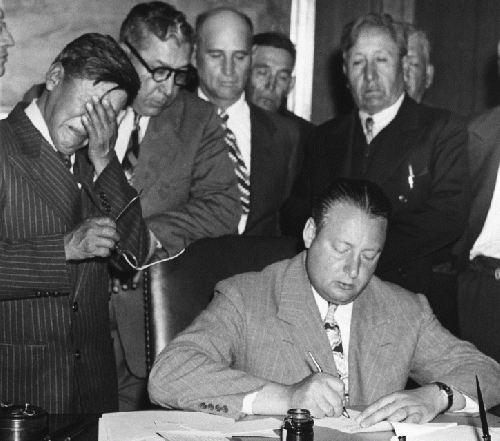"To keep the connection between the Indian person and the land--which is being severed by so many things." ~~ Marilyn Hudson
Frank Jr. Molley of Honor the Earth and I had an appointment to meet with Marilyn Hudson and discuss the work of the Land Owner's Association of Fort Berthold, and we were late. Negotiating construction, heavy load trucks, dust, potholes, stones kicked up by speeding trucks, mesmerizing gas flares, and ruts that looked like miniature gorges slowed us down considerably as we drove west on Highway 23 to the peaceful little community of Parshall, North Dakota. Located just south of the highway, Parshall is within the boundaries of the Fort Berthold Indian Reservation--home to the Three Affiliated Tribes of the Mandan, Hidatsa, and Arikara Nations. It was obvious that the use of horizontal drilling and hydraulic fracturing to tap into the massive Bakken Oil Formation had unleashed a maelstrom of unstoppable, damaging, and unpredictable industrial development.
Three years ago estimates indicated 577 billion barrels of oil were under the Bakken Formation, and Fort Berthold is considered the "sweet spot" for oil extraction. Since the implementation of a number of new test wells, estimates have been revised to 903 billion barrels of oil, an increase of 57 percent in less than three years.
After several cell phone conversations directing us to the door of her modest bungalow, Marilyn greeted us at the door and asked us to join her at the kitchen table. At 77 years and counting, Marilyn does not appear to be slowing down at all. The Mickey Mouse watch strapped to her left wrist was an affirmation of her quirky sense of humor and an open personality that was trusting of the strangers she invited into her home.
Marilyn Hudson's father was full-blooded Hidatsa/Mandan and her mother was Norwegian. Marilyn has lived in the area for most of her 77 years. Her passion at this stage of her life, after working for the Bureau of Indian Affairs and now as an administrator at the Museum of the Three Affiliated Tribes, is establishing an online database that will keep tribal members informed about the impact of oil exploration on the reservation.
"The history of the oil boom and our tribal histories reflect good and bad decisions," she said. "The poor decisions will haunt our tribe for the rest of its existence."
Haunted by Decisions
Fort Berthold has good reason to be haunted by recent decisions that were made by the tribal government, as well as those that were historically forced upon the people by the government of the United States.
Fort Berthold Reservation is located in western North Dakota and today encompasses about one million acres--a fraction of its ancestral range. The beautiful Missouri River Valley has been home to this agricultural people for hundreds of years. As a result, religious and spiritual ties to the land and sacred sites run strong. In the December 2011 issue of the "North Dakota Law Review," Raymond Cross discusses the social and environmental needs of the Three Affiliated Tribes as Fort Berthold faces unprecedented challenges during the boom. Will the reservation become development's victim or its beneficiary? Cross concludes that oil and gas development must be subjected to "reasonable legal and social regulation."
The original territorial lands of the Three Affiliated Tribes included an area reaching from east of the Missouri River to Montana, and south to what is now Nebraska and Wyoming. The Fort Laramie Treaty of 1851 established the size of the reservation from about 12 to 13.5 million acres, and subsequent acts of Congress reduced Fort Berthold to about 930,000 acres, which now also includes white-owned land.
Lake Sakakawea covers 155,000 acres of reservation land, and "covers" is the operative word. The Garrison Dam Project flooded the bottomlands of the Missouri River and completely obliterated many of the long-established Indian population centers of the Fort Berthold Reservation. Before the reservoir was built, 289 out of 357 households were located in the reservoir area. The current resident Indian population of the Reservation is approximately 3,776, with an enrolled population of 9,500. Many moved away after the "takings" of the Garrison Dam Project destroyed culture, fertile growing lands and a sense of place.
History records that the then residing Three Affiliated Tribes Council Chair, George Gillette, was coerced into signing off on the takings of the Garrison Dam Project. Gillette wept uncontrollably as he signed the coerced agreement.
Tribal Chaiman George Gillette Weeps by NIH
G eorge Gillette (left), chairman of the Fort Berthold Indian Tribal Business Council, weeps as Secretary of Interior J.A. Krug signs a contract whereby the tribe sells 155,000 acres of its reservation in North Dakota for the Garrison Dam and Reservoir project, 1948.
In 1947, the 80th Congress approved PL 296 which appropriated funds for "Flood Control, General." The Three Affiliated Tribes drew up a contract in 1948 for approval. Indians feared that if they failed to consent to outlined terms, they would receive less adequate compensation in the future. In tears, Council Chairman George Gillette "consented" to the coercive piece of legislation. "The truth is, as everyone knows," he said, "our Treaty of Fort Laramie...and our constitution are being torn to shreds by this contract".
There were nine communities lost to the flooding of the Garrison Dam. These were Elbowoods, Red Butte, Sanish, Lucky Mound, Nishu, Beaver Creek, Independence, Shell Creek, and Charging Eagle. These communities had a sawmill, schools, a hospital, government buildings, churches, community playgrounds parks and cemeteries.
(Note: You can view every article as one long page if you sign up as an Advocate Member, or higher).






